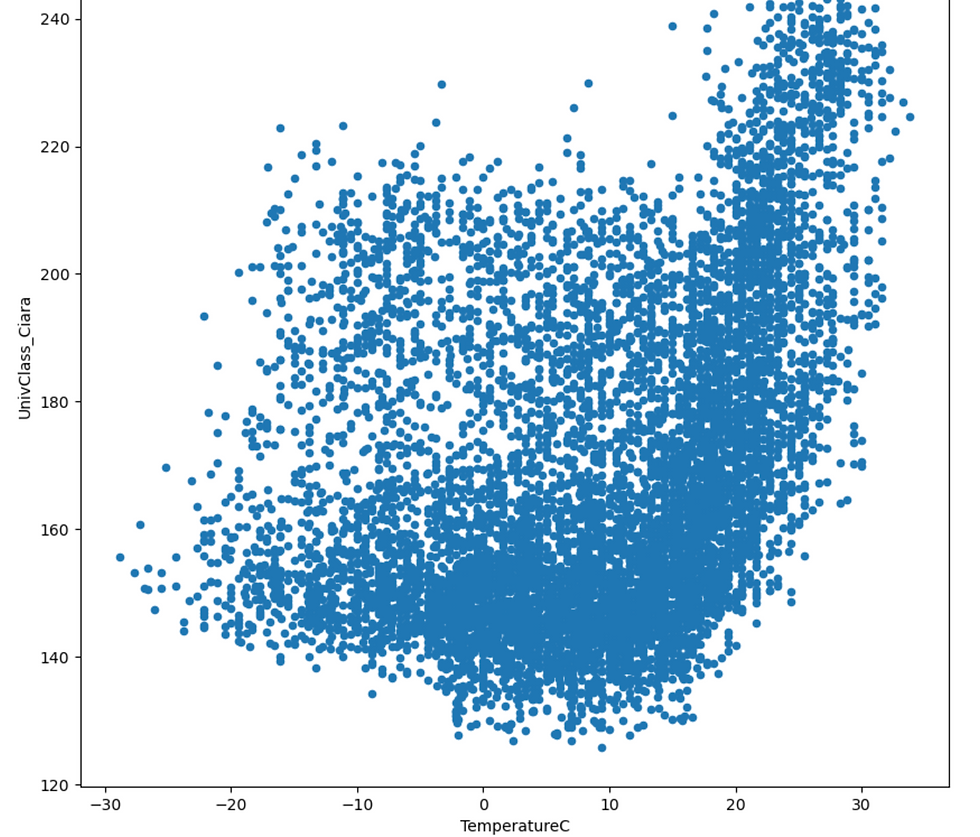Electricity Consumption Time Series Data visualization
- saman aboutorab
- Jan 18, 2024
- 1 min read
Updated: Feb 12, 2024
Embarking on an in-depth exploration of time-series data within the Building Data Genome Project, our focus centers on unraveling the intricacies of electricity energy consumption in the context of office buildings. Adopting a comprehensive approach, we intend to analyze the temporal patterns of energy usage and correlate them with pertinent weather data to discern the impact of climatic conditions on energy demands. By specifically honing in on office spaces, we aim to uncover nuanced insights into how weather variations influence the electricity consumption dynamics within professional environments. This multifaceted investigation not only illuminates the unique energy profiles of office buildings but also seeks to establish connections between external meteorological factors and the fluctuating energy needs of these spaces. Through this integrated analysis, we aspire to contribute valuable knowledge that aids in optimizing energy efficiency strategies tailored specifically for office infrastructures within the Building Data Genome Project.

import pandas as pddirectory = 'meter_data/'abigail = pd.read_csv(directory + 'Office_Abigail.csv', index_col = "timestamp", parse_dates=True) abigail.info()abigail.index[0]Timestamp('2015-01-01 00:00:00') abigail.indexPlotting Time-Series Chartsabigail.plot()abigail.plot(marker='.', alpha=0.5, linestyle='None', figsize=(15, 5))Resample the data to other frequenciesabigail_daily = abigail.resample("D").mean()abigail_daily.plot(figsize=(10,5))abigail_daily.resample("M").mean().plot(figsize=(10,5))abigail_daily_june = abigail_daily.truncate(before = '2015-06-01', after='2015-07-01')abigail_daily_june.plot(figsize=(10,5))Trends Analysis and Rolling Windowsabigail.rolling(window=500, center=True, min_periods=500).mean().plot()
list_of_buildings = ['UnivClass_Andy.csv',
'Office_Abbey.csv',
'Office_Alannah.csv',
'PrimClass_Angel.csv',
'Office_Penny.csv',
'Office_Pam.csv',
'UnivClass_Craig.csv',
'UnivLab_Allison.csv',
'Office_Amelia.csv',
'Office_Aubrey.csv']all_data_list = []
for buildingname in list_of_buildings:
df = pd.read_csv(directory + buildingname, index_col = "timestamp", parse_dates=True)
df = df.resample("H").mean()
all_data_list.append(df)
all_data = pd.concat(all_data_list, axis=1)all_data.info()all_data.plot(figsize=(20,30), subplots=True);all_data.resample("D").mean().plot(figsize=(20,30), subplots=True);all_data.resample("D").mean().truncate(after='2015-06-01').plot(figsize=(20,30), subplots=True)Normalization based on floor areameta = pd.read_csv("all_buildings_meta_data.csv", index_col="uid")meta.loc[buildingname]
rawdata_normalized = rawdata/meta.loc[buildingname]["sqm"]rawdata_normalized_monthly = rawdata_normalized.resample("M").sum()rawdata_normalized_monthly.plot(kind="bar", figsize=(10,4), title='Energy Consumption per Square Meter Floor Area')Automation of the process of analysis on multiple buildingsbuildingnamelist = ["Office_Abbey",
"Office_Pam",
"Office_Penny",
"UnivLab_Allison",
"UnivLab_Audra",
"UnivLab_Ciel"]annual_data_list = []
annual_data_list_normalized = []for buildingname in buildingnamelist:
print("Getting data from: "+buildingname)
rawdata = pd.read_csv(directory + buildingname + ".csv", parse_dates=True, index_col='timestamp')
floor_area = meta.loc[buildingname]["sqm"]
annual = rawdata.sum()
normalized_data = rawdata/floor_area
annual_normalized = normalized_data.sum()
annual_data_list_normalized.append(annual_normalized)
annual_data_list.append(annual) totaldata = pd.concat(annual_data_list)
totaldata_normalized = pd.concat(annual_data_list_normalized)Unnormalized energy consumptiontotaldata.plot(kind='bar',figsize=(10,5))Normalized Energy Consumptiontotaldata_normalized.plot(kind='bar',figsize=(10,5))
Weather Influence
file = "UnivClass_Ciara.csv"
directory = 'meter_data/'rawdata = pd.read_csv(directory + file, parse_dates=True, index_col='timestamp')rawdata.info()rawdata.plot(figsize=(10,4))Load Weather Datadirectory = 'weather_data/'
weather_data = pd.read_csv(directory + "weather2.csv", index_col='timestamp', parse_dates=True)weather_data.info()weather_data["TemperatureC"].plot(figsize=(10,4))Finding and removing outliersweather_hourly = weather_data.resample("H").mean()weather_hourly_nooutlier = weather_hourly[weather_hourly > -40]weather_hourly_nooutlier["TemperatureC"].plot(figsize=(10,4))
Filling gaps in data
weather_hourly_nooutlier_nogaps = weather_hourly_nooutlier.fillna(method='ffill')Merge Temperature and Electricity Data - Combining Data Setscomparison = pd.concat([weather_hourly_nooutlier_nogaps['TemperatureC'], rawdata['UnivClass_Ciara']], axis=1)comparison.plot(figsize=(20,10), subplots=True)Analyze the weather influence on energy consumptioncomparison.plot(kind='scatter', x='TemperatureC', y='UnivClass_Ciara', figsize=(10,10))import seaborn as snsdef make_color_division(x):
if x < 14:
return "Heating"
else:
return "Cooling"comparison = comparison.resample("D").mean()comparison['heating_vs_cooling'] = comparison.TemperatureC.apply(lambda x: make_color_division(x))g = sns.lmplot(x="TemperatureC", y="UnivClass_Ciara", hue="heating_vs_cooling",
truncate=True, data=comparison)
g.set_axis_labels("Outdoor Air Temperature", "Average Hourly kWH") |
Reference:
- Data Science for Construction, Architecture and Engineering by Clayton Miller (clayton@nus.edu.sg - miller.clayton@gmail.com): https://www.edx.org/learn/data-science/the-national-university-of-singapore-data-science-for-construction-architecture-and-engineering - Simulation files by Miguel Martin (miguel.martin@u.nus.edu.sg) - Building Data Genome Project: https://github.com/buds-lab/the-building-data-genome-project




























Comments